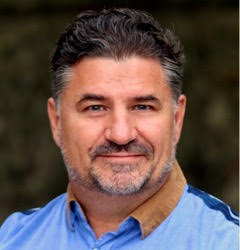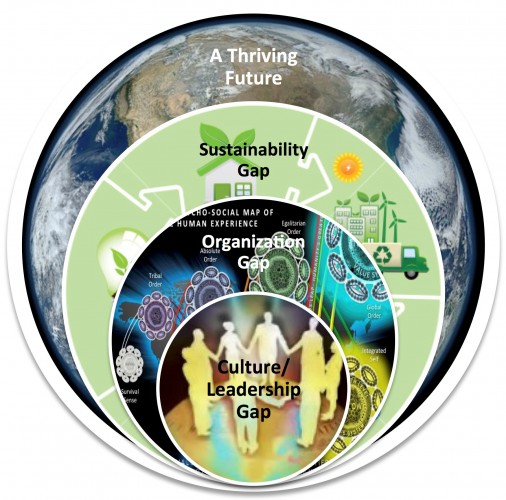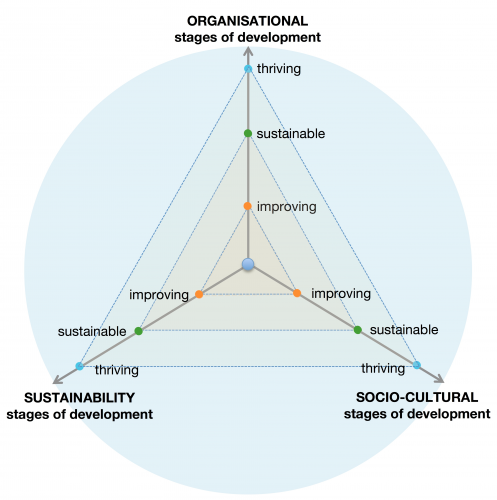Robin Lincoln Wood

Overview of the Purpose of this Series of Articles
– with excerpts from “A Leader’s Guide to ThriveAbility”
This series of articles is intended to illuminate how an integral approach to leadership can help us meet the critical leadership challenges of the 21st century. We apply the perspective and frameworks of ThriveAbility to gain a unique vantage point on how integral leadership embedded in a Thriveability approach offers powerful advantages to those seeking to ensure a thriving future for us all. Short excerpts from the recently published, much acclaimed book: “A Leader’s Guide to ThriveAbility” are also included.
There are a wide variety of often-contradictory perspectives on leadership in the world today, reflecting the many different centers of gravity of the developmental levels and cultures in the 193 very different countries on our planet. We are in the midst of a Tower of Babel of leadership approaches, reflecting the spectra of cultural polarities – for example, top down vs bottom-up, distributed vs concentrated, individualistic v collective, analytical vs intuitive, being some of the most prominent.

We must be able to not only recognize the importance of the diversity of ideas and approaches, but also enhance our ability to integrate the various perspectives competing for dominance in any situation, such that the decisions we take are more likely to be ThriveAble. The ThriveAbility approach provides a means to synthesize and thus integrate a number of key elements missing from the current discussion, including highlighting the trade-offs in various situations.
This enables us to have a much broader and compassionate view of the issues before us and provides us with much more comprehensive framework with which to align the diverse forces in and around an organization seeking to enhance the thriving of its key stakeholders for the smallest possible footprint. And in the long term to make the ‘world’ a healthier, more ThriveAble place for all.
The Plan for this Series of Articles
This series of articles on Integral Leadership for a Regenerative, Inclusive Economy follow a logical plan based on the ThriveAbility Journey which takes us where we need to be in 2050 to ensure a thriving planet inhabited by thriving people and civilizations:
- Introduction – The Key Leadership Challenge of the 21st Century
- What Kind of Leadership is Needed to Ensure a Thriving Future?
- Which Leadership Models are Capable of Delivering ThriveAbility?
- How ThriveAbility Leaders Deliver True Future Value
- How Can We Accelerate leadership Development for ThriveAbility ?
The first article in this series, „Introduction – What are the Leadership Challenges of the 21st Century?”, that follows, asks how we can use more effective leadership models and develop more effective leaders for a regenerative, inclusive economy.
Introduction –The Key Leadership Challenge of the 21st Century
„In short, leaders must be able and willing to step out of their current roles in society and become widely-accepted communicators of the way forward. They must be able to convince people to take a path that is both personally relevant as well as beneficial for themselves, their friends, family, their organizations, and the world as a whole.”
Dr. Anton G. Camarota – ThriveAbility Think Tank on Critical Leadership & Culture Shifts
The Challenge of Changing the Game, Fast
One of the world’s largest investors recently described our planet as being on a journey to an unstable destination, through unfamiliar territory, on an uneven road having already used its spare tire. Leadership today must take innovative actions that generate new capabilities and resources. We must become much smarter and more disciplined about every investment we make, whether it is time, energy or money.
Many leaders around the world understand all too well that the game we have been playing for several centuries is over, and that a new game is emerging that requires a significant change in the rules that govern how we conduct ourselves, our businesses and our governance systems. These new rules are still emerging, as are the goals that they shape for each of us, and our businesses and institutions.
Despite this understanding, it is proving difficult for most leaders to operationalize the changes they know are needed, due to a great deal of uncertainty around what that might mean for their most important stakeholders and the natural resistance to change that is inherent in many human systems. There is also reluctance to damage or risk what is still working until it is definitively broken, unless there are other real options on the table.
There are many different opinions as to what must be done. Some say that the “system” is beyond repair, and that we must get outside of it to change it. Others believe we can accelerate what is already working in the new, more sustainable game, and that this simply requires a better market, culture or technology to make the old game obsolete. There is an element of truth in both of these propositions- we certainly must shift our mind-sets to change the game, and we also have to preserve and promote the best of what is already working to survive and thrive in the process.
The most important attribute of all at this time, is to maintain an open mind and to be as agile and creative as possible in finding and promoting the radical new opportunities our current situation offers to innovative, entrepreneurial minds.
Toward a Regenerative, Inclusive Economy
Imagine a world powered by renewable energy, where all human beings thrive in resilient habitats; where businesses operate in a circular economy that regenerates natural capital, without a particle of waste, and are led by enlightened leaders whose goal is to maximize the ThriveAbility of all their stakeholders; where each individual is empowered to pursue their passion and make a living in service to others; where governance systems are transparent, effective and wise in the ways in which they deliver their services to their communities and populations; and where intercultural appreciation and insight enriches the exchanges between the diverse worldviews and cultures embraced by humankind.
Does that sound like an impossible dream, or pie in the sky? The co-creators of ThriveAbility would point out that every single one of these “pockets of the future” is currently observable in the present, right here and right now, somewhere in the world. It is just that the future is distributed unevenly, and sometimes hard to see when one is up to one’s neck in alligators and trying to drain the swamp.
- How would this desirable future scenario of a thriving human civilization on a thriving planet convert into practical outcomes that are measurable and manageable?
- What would such a future look like?
- What kinds of leadership are emerging to get us there?
These are some of the key questions we will seek to answer in this series of articles.
We can begin by describing in very big picture terms what a desirable future scenario of a thriving human civilization on a thriving planet might look like.
The Six Desiderata of ThriveAbility
Based on the pioneering work being done by hundreds of thought and practice leaders around the world[1], we have framed six desiderata by which we can measure the endpoint of the ThriveAbility Journey toward a regenerative, inclusive economy:
- Regenerative Business Models
- Intergenerational Investment Perspective
- True Future Value Metrics
- Industry Innovation Pathways
- Integrative Knowledge Leadership
- ThriveAble Governance Systems
1. Regenerative Business Models
- Natural and man-made materials and ecosystems are regenerated through circular economic processes
- All impacts are managed proportionately to the carrying capacities of the multiple capitals
- Intergenerational Investment Perspective
- Technologies, Products, Services and Businesses designed for durability to continue serving future generations
- Innovations are inspired by natural systems by engineers, designers, entrepreneurs and others working with the grain of nature.
3. True Future Value Metrics for a Regenerative Inclusive Economy
- Apply true accounting principles that measure true costs including externalities, and calculate true returns with full transparency
- Level the playing field towards renewable and regenerative industries through true taxation and incentives
4. Industry Innovation Pathways to Scale-Up to ThriveAble Sectors
- Nurture multi-stakeholder collaboration to amplify and scale up positive impacts
- Investment decisions based on the ThriveAbility Index
5. Integrative Knowledge Leadership to Develop Complex Systems Thinking & Integral Leadership Capacities
- New open business models for education that integrate physical wellbeing, mental depth, emotional maturity and spiritual development.
- Developmental pathways based on co-working and co-creation between disciplines and sectors that are aspirational and compelling for future generations
6. Stratified Governance Systems for Inclusive Stakeholder Wellbeing
- Radically inclusive and transparent governance structures that serve the different priorities and needs of different developmental levels
- Innovative structures for and approaches to interworking between governments, NGO’s, businesses and academia that focus on Stakeholder ThriveAbility.
We believe that starting from this “end of the telescope”, what is required for regenerative, inclusive business becomes obvious fairly quickly to key decision makers and stakeholders. In this sense the ThriveAbility Approach and Index act as a powerful catalyst and producer of the aspirations and the cognitive dissonance required to make transformative changes a reality.
To put it bluntly, we have no choice whether we should move from a degenerative, exclusive economic system to a regenerative, inclusive one that can ensure the thriving of our biosphere and ourselves. The big questions remaining are:
- how we are going to make this happen?
- what does regenerative and inclusive look like to different people at different stages of development in different cultures?
- how fast we are going to make this happen, and will that be in time?
- what kinds of leadership can ensure we make it?
At its simplest, ThriveAbility reframes the hairshirt aura of sustainability by focusing on the positive benefits of collectively living within our means (or, in geek-speak, operating within the carrying capacities of capitals.) ThriveAbility does this by weaving two additional dimensions into the sustainability equation that remedy the Social and Governance weakspots, while catalysing context-based environmental performance:
- The Organizational Dimension, or how to scale positive change up and across companies, industries, and entire sectors
- The Leadership/Socio-Cultural Dimension, or how to leverage mindset shifts to trigger positive social paradigm shifts.
ThriveAbility’s secret sauce is to mesh these interlocking dynamics. Focusing solely on closing the Sustainability Gap (as many of us have been doing for decades) has not solved our problems – we need to simultaneously transform the underlying mental models to liberate ourselves from frameworks that lock in unsustainability. And solutions need to migrate readily across organizational silos and permeate sectors.
In other words, we need to address the nested Three Gap Problem (Sustainability Gap; Organizational Gap; Socio-Cultural Gap) with an integral approach.
The Three Gap Problem

Let me repeat: an integral approach harnesses the synergies between solutions in ways that unleash a host of positive opportunities. “Wicked problems” require “wicked solutions” – namely, solutions that take into account the interdependencies of complex systems. The key is to replace interlocking dynamics that exacerbate undesirable outcomes, with dynamic interrelationships that positively reinforce desirable outcomes.
To do this, ThriveAbility closes all three gaps simultaneously by plotting them on three axes, to track how development on one axis affects development along the other axes. The goal is to drive delta – or positive change – in ways that trigger tipping points of progress.
The ThriveAbility Delta Pyramid

A few words about each axis:
- BIOSPHERE– The Sustainability (Z) Axis focuses on the technical aspect of collective impact within bounded systems. We know empirically that business-as-usual is unsustainable, both ecologically and socially. So the Z Axis measures progress toward operating within thresholds that divide sustainability from unsustainability in social and ecological systems. In other words, the Sustainability Axis is our thermometer of physical health.
- ORGANIZATIONS- The Organizational (Y) Axis measures how sustainability scales up. It tracks the expansion of sustainable attributes within and across an organization, and an industry, and ultimately, a sector. At the organizational level, it surveys 95 attributes as a barometer of where companies stand on the continuum from business-as-usual through incremental improvement to sustainability and beyond – net positive and ultimately gross positive impacts (or what we call thriveable!)
- LEADERSHIP- The Socio-Cultural (X) Axis promotes shifts in mindsets, focusing primarily on leaders who exemplify positive change and influence transformation throughout their organizations and across their sectors. It uses time-tested self-survey tools that prompt individuals to reflect on their progress through developmental stages to second-order abilities to navigate the complexities inherent in today’s – and tomorrow’s – world.
Sustainability, Scaling, and Shifting minds and paradigms – these are the interlocking goals of ThriveAbility.
In the next article in this series, we will explore “What Kind of Leadership is Needed to Ensure a Thriving Future?”
Thanks for listening!
About the Author
Robin has lived and worked in 35 countries on 4 continents. Through his passion for transformation and healthy globalisation, he has helped a few hundred of the world’s largest organisations catalyze major beneficial change and transformation. His lifelong passion for Environmental and Social Justice means he’s been an activist for 40 years, including co-leading the campaign for Nelson Mandela’s release and the end of apartheid. 24 years ago he worked with the World Bank to develop the first sustainable energy strategy for the first Rio conference. 21 years ago he helped to create the modern Internet and what we now know as E-Business with the pioneering firms of Silicon Valley. He has founded several businesses both as an intrapreneur in Citicorp, Ernst and Young and NYNEX/Verizon, as well as entrepreneurial ventures such as Genesys, Telesure and Chateau La Tour Apollinaire. Robin has been advising business and political leaders at all levels including many well known CEO’s and prime ministers, as an integrally informed practitioner, social entrepreneur and integral leader. Since creating the Renaissance2 Foundation in 2008 at La Tour Apollinaire, his green Chateau in France, Robin co-founded the ThriveAbility Foundation in London with his world-class colleagues to help leaders make more ThriveAble decisions through the ThriveAbility Approach, Program and Index.
Robin is also the author of several books, including the award winning “Managing Complexity”, “The Great Shift”, “Lifeshift 2020”, “The Trouble with Paradise” and “A Leader’s Guide to ThriveAbility”. He earned a doctorate at London Business School for his work on the strategic alignment wheel, and holds degrees in economics, law and international finance, and qualified as an advocate of the Supreme Court of South Africa. For further information, please go to www.rlw.zone.
The ThriveAbility Foundation is a global public good designed to co-deliver a thriving, inclusive operating space for humanity within a regenerative footprint through a transformative, values-based approach to decision-making and governance at alls scales, from communities to organisations to nations to markets. Through integrated decision modelling of the seven capitals using the ThriveAbility Equations, leaders can align breakthrough strategies with stakeholder aspirations that deliver thriveable competitive advantage. Through the ThriveAbility Index, investors are able to select a portfolio with superior performance based on the innovation pathways and collaborations informed by the multi-stakeholder ThriveAbility program and True Future value calculations, using science-based goals. For further information, please go to www.thriveability.zone.
[1] In the course of researching and writing “A Leader’s Guide to ThriveAbility” we met with and/or interviewed 83 global thought leaders, executives and investors shaping the future of business, sustainability and human flourishing during late 2014 and early 2015. Since then we have engaged with a further few hundred such leaders via ThriveAbility live gatherings, ThriveAbility Think Tanks hosted by Convetit, and videoconferencing.
